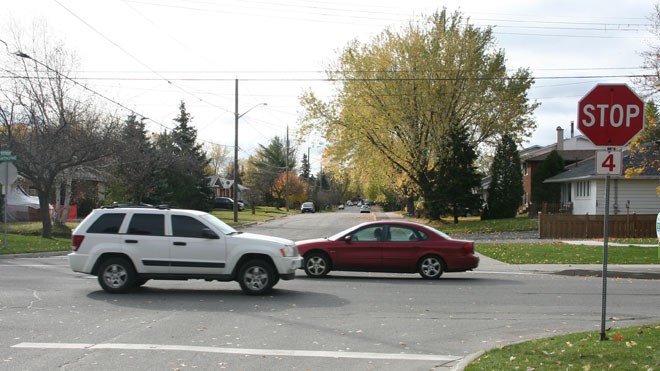Politically popular but practically problematic, city councillors voted this week to remove all-way stops signs at five intersections in New Sudbury and the South End.
The signs went up a year ago for a one-year trial period despite staff objections, after residents in the area signed petitions calling for them to be installed. At the time, some councillors said it was worth trying to see if they improved safety.
Four-way stop signs were installed at Bouchard Street at Marcel Street; Lansing Avenue at Melbourne Street; Hawthorne Drive at Westmount Avenue; Madeleine Avenue at Main Street; and, Madeleine Avenue at Alexander Street.
Normally, staff follows minimum traffic warrants to determine whether the signs would be effective in dealing with traffic concerns. David Shelsted, director of roads and transportation, said all-way stop signs are effective at intersections where traffic volumes are similar. When they're put in areas where traffic is much heavier on one street than the other, it clogs traffic on the busier street, leading to lineups.
Worse, frustrated drivers tend to stop stopping, either rolling through the sign or ignoring it completely. Studies by the traffic department at the five intersections bear that out, Shelsted said.
“For the newly installed intersections, approximately 27 per cent of the people actually were in full compliance when using the intersections, approximately 64 per cent came to a rolling stop, with almost nine per cent not stopping,” he said. “The worst compliance was at Madeleine Avenue at Alexander Street, with 30 per cent of vehicles not stopping.”
Putting stop signs in areas where you can predict drivers won't obey them is not only bad policy, it can be dangerous, he said.
“Drivers and pedestrians become less vigilant when the onus is on the drivers to stop,” Shelsted said. “This behaviour can decrease safety at the intersections, especially for young children who expect adults to obey the law. This bad behaviour can also spread to other locations where an all-way stop is warranted.”
The extra lineups also cost money and hurt the environment. The extra idling is estimated to waste about 228,000 litres of gas, or about $290,000.
And their survey showed the signs didn't slow traffic significantly, with speeds actually higher at the four-way stop at the Hawthorne Drive intersection. They also had a minimal impact on traffic volumes.
“The table shows that none of the intersections were collision prone before the installation of the all-way stops, and the collision data does not show a significant change in the past year,” Shelsted said. “In total, three collisions were reported for all five intersections since the all-way stops were installed and all three collisions were rear-end type collisions.
“Additionally, no collisions involving pedestrians have been reported since 2008 at any of the five intersections.”
While not disputing the findings, Ward 10 Coun. Frances Caldarelli said if the signs ease residents' concerns, what's the harm?
“The councillor knows whether the residents want them or not,” Caldarelli said. “Especially considering they're in already, what the residents want should trump” other concerns.
“So I will vote however the ward councillor (Ward 12 Coun. Joscelyne Landry-Altmann) wants. I don't think they're doing a great deal of harm.”
But Ward 11 Coun. Terry Kett said allowing people to feel safer when they're really not isn't the right thing to do.
“You can't be safe with stop signs that don't work,” Kett said.
He sees people doing rolling stops through the signs, and says that's dangerous “all the time. They touch their brakes, and they go through. And it's wrong.”
Ward 2 Coun. Jacques Barbeau said if councillors are going to ignore staff reports, then why ask for them? If they know they're not going to listen regardless, it's better not to waste taxpayer dollars.
“This report wasn't done in five minutes,” he said.
It's also hypocritical to support an anti-idling bylaw, then approve policies that unnecessarily increases idling, Barbeau said.
While he understands that residents like the stop signs, that's no way to formulate policy.
“Yes, they live in the area, but they're not traffic experts,” he said.
While it's tough to tell residents "no" when they ask for a new stop sign, it's part of their responsibilities to explain the reason, rather than ignore staff advice.
“It's tough to go back to your residents – I know, I've done it,” he said. “That's life. Otherwise, we're going to have four-way stops at every intersection in this city.”
But Landry-Altmann, an advocate for more traffic signs and signals in the city, said residents have told her clearly they support the signs and want them to stay. If people are ignoring them, the police should get involved, she said.
“They feel it is calming the traffic down,” Landry-Altmann said. “Having at least the stop sign, (the residents feel) the speed has been significantly reduced.”
Infrastructure GM Tony Cecutti said traffic calming measures are the way to deal with those types of concerns, not stop signs.
“There are more appropriate measures out there,” Cecutti said.
With the road reconstruction going on in the area, residents near one of the signs will be asked what sort of calming measures they prefer instead of the signs, Cecutti said.
